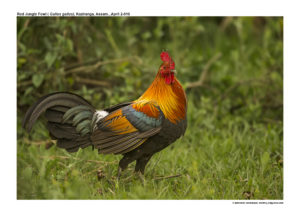
Red-jungle Fowl Gallus gallus
Etymology:
- Gallus : Latin word for farmyard cock
- Gallus: Latin word for farmyard cock
Vernacular Names:Hindi: Jungli Murgha, Ban Murgha, (M) Laal murgha, (F) Jungli murghi, Ban murghi, Pun: Jungli murga, Ben: Jungli Murgha, Ban Murgha, (M) Laalmurgha, (F) Jungli murghi, Ban murghi, Ass: Ban kukura, Te: Yerraadavikodi, Guj: Laaljunglikukdo, Mar: Laal ran kombda, Ori: Jungalikukuda, Burmese: Taw kyet
Distribution in India: Resident of Himalayas, North East and East India.
Description: Size of male is 65–78 cm, wt. of male is 672–1450 g; size of female is 41–46 cm, wt. of female is 485–1050 g. Male has a rufous-orange hackles, blackish-brown underparts, rufous wing panels, white tail base and long greenish-black sickle shaped tail. In the eclipse plumage the hackles are replaced with short dark brown feathers and the central tail feathers are missing.The female has a shawl of elongated feathers that are edged golden-buff and black centered. It has a rufous head and naked reddish face.The immature male has less developed hackles and smaller tail and is duller. It is found in tropical and subtropical habitats.
Habitat: It is found from sea-level up to 2400.There is a clear habitat segregation in areas of overlap G. sonneratii, (Grey Jungle fowl). The present species is closely associated with moister sal forest, whereas sonneratii prefers drier teak forest.
Food habits: It eats seeds and small invertebrate. The food is procured by scratching ground and picking at items. It visits more open areas in early morning and evening to feed, and waterholes on daily basis during dry periods. It is seen in small groups, comprising a male with several females. It follows mammals, wild and domestic, taking insects flushed by them or attracted to their dung.
Breeding habits: They breed in Mar–May in India, Mar–Jun in Bangladesh; Dec–Jun and Aug in Thai-Malay Peninsula and Feb–May in China. They are polygamous, with the number of females associated with a given male appearing to increase as breeding season advances. The nest is a shallow scrape in dense secondary growth or bamboo forest, lined with dry grass, palm fronds and bamboo leaves, and sited under bushes or in clumps of bamboo, but sometimes in tree fork. They lay a clutch of 5–6 eggs. The incubation period is 18–21 days, done by female alone. Females prefer males with longer and redder combs, but apparently pay little heed to other plumage characters in their mate choice.